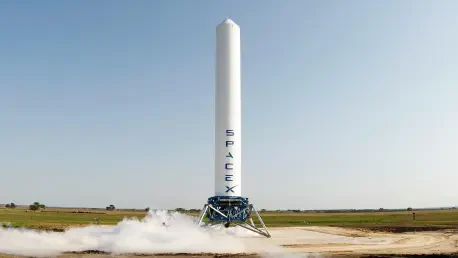In a striking testament to resilience and cutting-edge technology, SpaceX achieved a significant milestone by successfully launching the Nusantara Lima satellite for Indonesian operator PT Pasifik Satelit Nusantara on September 11 from Cape Canaveral Space Force Station in Florida. This mission, which finally took off at 9:56 p.m. after three consecutive nights of weather-related delays, exemplifies the challenges and triumphs inherent in modern spaceflight. The Falcon 9 rocket’s ascent into the night sky not only marked a victory over persistent adverse conditions but also highlighted SpaceX’s critical role in supporting global telecommunications infrastructure. As the 77th orbital launch of the year from the Space Coast, this event underscores the region’s burgeoning status as a central hub for space exploration and commercial endeavors. The detailed coverage of the launch process reveals a narrative of patience, precision, and international collaboration, setting the stage for a deeper exploration of the mission’s impact and implications.
Battling the Elements for Launch Success
The journey to launch the Nusantara Lima satellite was fraught with obstacles, primarily driven by unpredictable weather patterns that tested SpaceX’s operational flexibility. For three consecutive nights prior to September 11, attempts to send the Falcon 9 into orbit were halted due to heavy cloud cover and the looming threat of storms. On the crucial evening, the Space Force’s 45th Weather Squadron provided a forecast with a modest 45% chance of favorable conditions, citing concerns over cumulus clouds and surface electric fields. As the hours ticked by, radar observations indicated a slow but promising shift, with clouds moving offshore from Cape Canaveral. This gradual improvement kept hope alive among the teams monitoring the situation, illustrating how heavily space missions rely on precise meteorological data to ensure safety and success.
Ultimately, the perseverance paid off as the launch window neared its end. Multiple delays had pushed the liftoff time to the brink, reflecting the delicate balance between adhering to safety protocols and seizing fleeting opportunities. The decision to proceed at 9:56 p.m. came after meticulous coordination between SpaceX engineers and weather experts, ensuring that conditions were just right for the rocket to pierce through the night sky. This success after repeated setbacks serves as a powerful reminder of the uncontrollable variables in space operations and the importance of adaptive scheduling. The ability to wait out unfavorable weather while maintaining mission readiness showcases the sophisticated support systems and decision-making processes that underpin such endeavors.
Engineering Excellence in Reusable Rocketry
Once the weather barrier was surmounted, the technical prowess of the Falcon 9 rocket took center stage, demonstrating SpaceX’s leadership in reusable technology. The prelaunch sequence unfolded seamlessly, with fueling operations kicking off as planned, evidenced by the telltale water vapor near the rocket’s base signaling cryogenic fuel loading. Key milestones in the countdown, such as engine chill at T-minus 7 minutes and final system checks just before liftoff, were executed with precision, culminating in a flawless ascent from Launch Complex 40. This smooth progression from preparation to ignition reflects the rigorous engineering standards and operational discipline that have become synonymous with SpaceX missions.
A standout achievement of this mission was the performance of the first-stage booster, which completed its 23rd flight—a remarkable feat in the realm of reusable rocketry. Having previously supported high-profile missions like Crew-6 and numerous Starlink deployments, the booster’s successful landing on the drone ship A Shortfall of Gravitas in the Atlantic Ocean, just over 8 minutes after launch, reaffirmed SpaceX’s innovative approach to reducing costs and enhancing launch frequency. This landing, executed with pinpoint accuracy far out at sea, avoided sonic booms over local areas and highlighted the company’s mastery of recovery operations. Such reusability not only drives economic efficiency but also pushes the boundaries of sustainable space exploration, setting a benchmark for the industry.
Enhancing Global Communication Networks
The core purpose of the mission—to deploy the Nusantara Lima satellite—carries profound implications for telecommunications in Indonesia, reflecting SpaceX’s role in fostering global connectivity. Built by Boeing for PT Pasifik Satelit Nusantara, this satellite is poised to strengthen communication infrastructure across the region, addressing critical needs for reliable connectivity in both urban and remote areas. While detailed specifications of the satellite’s capabilities were not extensively covered in real-time updates, its deployment marks a significant step forward in bridging digital divides. The international collaboration behind this project underscores the growing trend of private space companies partnering with global entities to meet diverse technological demands.
Beyond its functional purpose, the satellite represents a symbol of technological partnership between American and Indonesian entities, facilitated by SpaceX’s launch expertise. Visual documentation from Boeing’s factory in El Segundo, California, provided a glimpse into the meticulous preparation of Nusantara Lima before its journey to orbit. This mission’s success adds to the portfolio of international payloads delivered by SpaceX, reinforcing their position as a key player in enabling worldwide communication advancements. The broader impact of such missions lies in their ability to empower nations with the tools needed for economic and social development through enhanced access to information and connectivity.
The Space Coast as a Launch Powerhouse
The Nusantara Lima mission also shines a spotlight on the Space Coast’s evolving role as a dynamic center for space activities, with Cape Canaveral Space Force Station and NASA’s Kennedy Space Center driving significant launch traffic. This particular launch marked the 77th orbital mission of the year from the region, a statistic that speaks volumes about the area’s strategic importance in both commercial and governmental space endeavors. SpaceX’s substantial contribution to this tally reflects their dominance in the sector, supported by robust infrastructure like Launch Complex 40 and advanced recovery assets such as drone ships positioned in the Atlantic for post-launch operations.
Notably, the eastward trajectory of this Falcon 9 flight ensured that recovery operations occurred far from shore, eliminating the possibility of sonic booms disturbing residents of Brevard County. This thoughtful mission planning, combined with the high frequency of launches, illustrates the Space Coast’s capacity to handle complex operations while minimizing local impact. The region’s growth as a launch hub is emblematic of broader trends in the commercialization of space, where private enterprises like SpaceX play a pivotal role in expanding access to orbit. As activity continues to ramp up, the Space Coast stands as a testament to innovation and collaboration in the modern space era.
Reflecting on a Milestone Achievement
Looking back, the successful launch of the Nusantara Lima satellite by SpaceX on September 11 stood as a defining moment of determination and technical mastery, overcoming three nights of weather-induced postponements to achieve liftoff at 9:56 p.m. from Cape Canaveral. The Falcon 9’s impeccable performance, coupled with the first-stage booster’s landing on A Shortfall of Gravitas, cemented SpaceX’s reputation for reliability and sustainability in spaceflight. This mission not only advanced telecommunications for Indonesia but also contributed to the Space Coast’s impressive record of launches. Moving forward, the focus should shift to leveraging such successes to further refine weather prediction models and enhance launch scheduling flexibility. Additionally, fostering more international partnerships can amplify the global impact of space technology, ensuring that missions like this continue to pave the way for connectivity and progress across borders.









